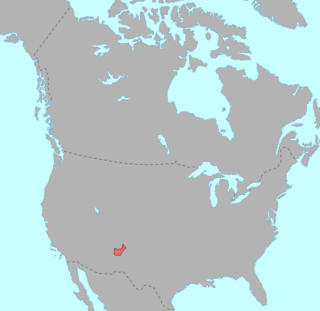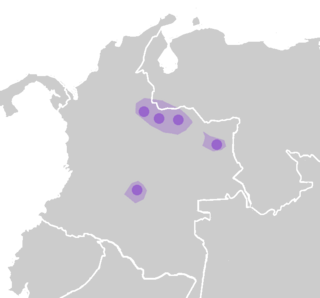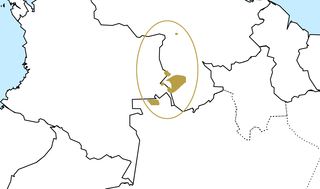
Macro-Arawakan is a proposed language family of South America and the Caribbean centered on the Arawakan languages. Sometimes, the proposal is called Arawakan, and the central family is called Maipurean.
Arawak, also known as Lokono, is an Arawakan language spoken by the Lokono (Arawak) people of South America in eastern Venezuela, Guyana, Suriname, and French Guiana. It is the eponymous language of the Arawakan language family.

Carib or Kari'nja is a Cariban language spoken by the Kalina people (Caribs) of South America. It is spoken by around 7,400 mostly in Venezuela, Guyana, Suriname, French Guiana, and Brazil. The language is currently classified as highly endangered.

Keres, also Keresan, is a Native American language, spoken by the Keres Pueblo people in New Mexico. Depending on the analysis, Keres is considered a small language family or a language isolate with several dialects. The varieties of each of the seven Keres pueblos are mutually intelligible with its closest neighbors. There are significant differences between the Western and Eastern groups, which are sometimes counted as separate languages.

Arawakan, also known as Maipurean, is a language family that developed among ancient indigenous peoples in South America. Branches migrated to Central America and the Greater Antilles in the Caribbean and the Atlantic, including what is now the Bahamas. Almost all present-day South American countries are known to have been home to speakers of Arawakan languages, the exceptions being Ecuador, Uruguay, and Chile. Maipurean may be related to other language families in a hypothetical Macro-Arawakan stock.

Isthmus Zapotec, also known as Juchitán Zapotec, is a Zapotecan language spoken in Tehuantepec and Juchitán de Zaragoza, in the Mexican state of Oaxaca. According to the census of 1990 it has about 85,000 native speakers, however this number is rapidly decreasing, as speakers shift to Spanish.

Otomi is an Oto-Pamean language family spoken by approximately 240,000 indigenous Otomi people in the central altiplano region of Mexico. Otomi consists of several closely related languages, many of which are not mutually intelligible. The word Hñähñu[hɲɑ̃hɲṹ] has been proposed as an endonym, but since it represents the usage of a single dialect, it has not gained wide currency. Linguists have classified the modern dialects into three dialect areas: the Northwestern dialects are spoken in Querétaro, Hidalgo and Guanajuato; the Southwestern dialects are spoken in the State of Mexico; and the Eastern dialects are spoken in the highlands of Veracruz, Puebla, and eastern Hidalgo and villages in Tlaxcala and Mexico states.

Guajiboan is a language family spoken in the Orinoco River region in eastern Colombia and southwestern Venezuela, a savanna region known as the Llanos.
Terêna or Etelena is spoken by 15,000 Brazilians. The language has a dictionary and written grammar. Many Terena people have low Portuguese proficiency. It is spoken in Mato Grosso do Sul. 20% are literate in their language, 80% literate in Portuguese.
Piro is a Maipurean language spoken in Peru. It belongs to the Piro group which also includes Iñapari (†) and Apurinã. The principal variety is Yine. The Manchineri who live in Brazil (Acre) and reportedly also in Bolivia speak what may be a dialect of Yine. A vocabulary labeled Canamaré is "so close to Piro [Yine] as to count as Piro", but has been a cause of confusion with the unrelated Kanamarí language.
Murui Huitoto is an indigenous American Huitoto language of the Witotoan family. Murui is spoken by about 1,100 Murui people along the banks of the Putumayo, Cara-Paraná and Igara-Paraná rivers in Colombia. In Peru it spoken in the North alongside the Ampiyacu and Napo rivers by some 1,000 people. Some Murui speakers live also outside their territories, for instance the vicinity of Leticia, Amazonas, Colombia.
Barasana is one of the various languages spoken by the Indigenous peoples of the Americas belonging to the Amazonian region, specifically in Colombia. It belongs to the Eastern branch of the Tucanoan language family. The people who speak the language are also known as the Barasana. The population of its native speakers is about 1,990 according to a census taken in 1993. Native speakers' tribes are spread out among the Pira Paraná River in Colombia and the banks of the Vaupés River Basin.
The Cubeo language is the language spoken by the Cubeo people in the Vaupés Department, the Cuduyari and Querarí Rivers and their tributaries in Colombia, and in Brazil and Venezuela. It is a member of the central branch of the Tucanoan languages. Cubeo has borrowed a number of words from the Nadahup languages, and its grammar has apparently been influenced by Arawak languages. The language has been variously described as having a subject–object–verb or an object–verb–subject word order, the latter very rare cross-linguistically. It is sometimes called Pamiwa, the ethnic group's autonym, but it is not to be confused with the Pamigua language, sometimes called Pamiwa.

Taíno is an extinct Arawakan language that was spoken by the Taíno people of the Caribbean. At the time of Spanish contact, it was the most common language throughout the Caribbean. Classic Taíno was the native language of the Taíno tribes living in the northern Lesser Antilles, Puerto Rico, the Turks and Caicos Islands, and most of Hispaniola, and expanding into Cuba. The Ciboney dialect is essentially unattested, but colonial sources suggest it was very similar to Classic Taíno, and was spoken in the westernmost areas of Hispaniola, the Bahamas, Jamaica, and most of Cuba.

Karu, one of several languages called Baniwa (Baniva), or in older sources Itayaine (Iyaine), is an Arawakan language spoken in Guainía, Colombia, Venezuela, and Amazonas, Brazil. It forms a subgroup with the Tariana, Piapoco, Resígaro and Guarequena languages. There are 10,000 speakers.
Wapishana (Wapixana) is an Arawakan language of Guyana and Brazil. It is spoken by over 6,000 people on both sides of the Guyana-Brazil border.
Mawayana (Mahuayana), also known as Mapidian (Maopidyán), is a moribund Arawakan language of northern South America. It used to be spoken by Mawayana people living in ethnic Wai-wai and Tiriyó villages in Brazil, Guyana and Suriname. As of 2015, the last two speakers of the language are living in Kwamalasamutu.
Barawana (Baré) is an Arawakan language of Venezuela and Brazil, where it is nearly extinct. It was spoken by the Baré people. Aikhenvald (1999) reports "just a few old speakers left" of Baré proper, and that the Guinau variety was extinct. Kaufman (1994) considers Baré proper, Guinau, and Marawá to be distinct languages; Aikhenvald, dialects of a single languages.
Yawalapiti (Jaulapiti) is an Arawakan language of Brazil. The Agavotaguerra (Agavotoqueng) reportedly spoke the same language. Speakers of the language live in a village along the edge of the river Tuatuari, a tributary of the Kuluene River, located in the southern part of the Xingu Indigenous Park, in the state of Mato Grosso.
The Pidjanan languages are a subgroup of Arawakan languages of northern South America.









